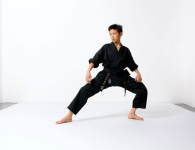
Almost everyone knows what shadowboxing is, but why we do it and how to shadowbox properly are probably less common knowledge.
Anyone who has watched a movie about boxing, or a pre-game clip before a boxing match or MMA fight has seen shadowboxing in action. Maybe they’ve even tried it. But there’s a lot more to this art than meets the eye. What might look like random air punching to the uninitiated eye is actually a highly specific form of combat sports training with specific purposes and specific execution.
So what are the goals of shadowboxing? What are the benefits of this form of training? Is shadowboxing just for boxers, or can martial artists and combat fighters from other disciplines gain from it?
Let’s take a closer look.
What are the benefits of shadowboxing?
When you shadowbox properly, you are building and strengthen your foundation as a fighter. Shadowboxing is where you establish how you throw your strikes, as well as how you move your feet and hands in both offence and defence. It’s where you develop your technique, your reflexes, and your personal style as a fighter. And it’s where you reinforce all of the above by building muscle memory. As you solidify your techniques, you can also begin to work on your speed through shadowboxing.
In addition to all of the physical benefits that proper shadowboxing offers, it’s also an excellent way to develop the mental side of your boxing training. Shadowboxing is where you can pay attention to your breathing, and learn to connect it to your movements. This is where you can improve the composure and the stress management skills that you’ll need for sparring and competition. Shadowboxing deepens your mind/body connect and improves your confidence.
And it’s a great workout.
Who should shadowbox?
Shadowboxing is an essential part of any good boxing training program. If you want strong and precise strikes, solid footwork, good head movement, and a sharp mind — basically if you want to be good at boxing at all — you will need to shadowbox regularly and properly. Shadowboxing can also be a component of kickboxing, Muay Thai, and MMA training.
That doesn’t mean that shadowboxing is or should be limited to boxers, kickboxers, Muay Thai fighters, and mixed martial artists alone, though. Anyone who is interested in adding shadowboxing to their training routine can benefit from the practice. It’s a good form of cardio and a good form of strength and toning exercise. Even regular lifters might be surprised at how much DOMS they feel in their lats the day after their first proper shadowboxing session. Shadowboxing is a great form of exercise for people who are looking for a new challenge, but don’t have access to a gym or a lot of equipment. And an excellent option for anyone who’s looking for a new form of stress relief.
What do you need to shadowbox?
In theory, all you need to shadowbox is yourself. Part of the appeal of shadowboxing is that you can do it almost anywhere and it requires no equipment or martial arts gear. That said, there are a few things you’ll probably want to have access to if you’re going to shadowbox properly.
First, you will need enough space to make sure you are able to safely and properly execute all aspects of your shadowboxing training. You’ll need room to punch — and to kick if you’re doing kickboxing or Muay Thai shadowboxing — as well at least a few steps in each direction to make sure your footwork won’t be limited. You might also want to consider putting down jigsaw mats for comfort, especially if you’re working barefoot. If you are moving and pivoting properly, shadowboxing, bare feet, and hardwood floor or carpet can be a painful combination!
You will also need some type of feedback for your form. Ideally, this will be another person, especially when you’re still getting the hang of proper shadowboxing and developing your style and form. If you can’t work with a coach or training partner in person, you can arrange a video conference appointment, book a virtual martial arts training session. You can film yourself and send the video of your shadowboxing and send it to a coach or mentor for constructive criticism. If you have to work alone, shadowboxing in a mirror can help you keep an eye on your own form.
How do you shadowbox properly?
Warm up: Some people make the mistake of treating it like a warmup, but proper shadowboxing is its own form of training and exercise, and like any type of training, doing it well and safely will require getting your body and mind prepared to tackle the work ahead of you. Begin with about 5-10 minutes of dynamic stretching and light cardio, like an easy jump rope routine, before you begin shadowboxing in earnest.
Get into position: Assume the basic boxing stance (or kickboxing stance, or Muay Thai stance) just like you would in technique training, sparring, or a fight.
Don’t hold back: When you shadowbox, you’re building muscle memory. If you’re not careful with your techniques, or get sloppy in your form, that carelessness will eventually start showing in your sparring and fighting. To develop and reinforce good habits, shadowbox with proper technique, power, and speed. In addition to your strikes, make sure that you are also focusing on your head movement, your footwork, your feinting and parrying. And don’t forget to use your imagination! Visualize your opponent, visualize your game plane, and connect your thoughts to your actions.



















